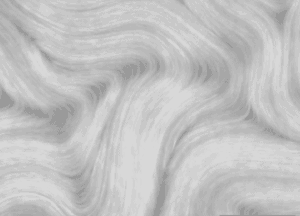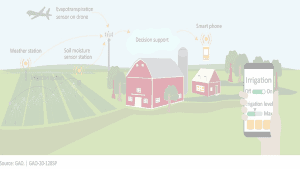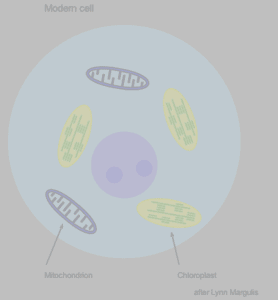Have you ever thought that your next piece of jewelry could be made by tiny animals instead of by humans? Or that this animals’ silk could potentially be used even in surgery in the near future? If these questions have surprised you and you are wondering what this is all about, the answer might still keep you intrigued: caddisflies.
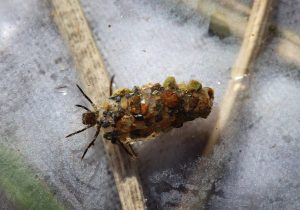
Neophylax concinnus larva in its case.
Some of you, however, might now be asking yourselves the following: what are caddisflies? They are small insects with an aquatic larval phase that look very similar to a worm, but with three pairs of legs at the front. At some point, these insects undergo metamorphosis and become a terrestrial adult with wings and very long antennae. These larvae live in freshwater ecosystems (e.g., ponds, lakes, rivers, streams, and ditches) across almost all over the world; from the Arctic to warm regions like Brazil, Africa or even Australia. One of their coolest features is that some species have silk-producing glands similar to those found in spiders. Researchers like Russell Stewart at the University of Utah have been analysing this silk’s composition with the aim to find possible applications. For instance, it has been suggested that it could be used as a bioadhesive to stick wet tissues together, a useful application in the surgery field [1]. In addition, Stewart and collaborators have designed a toughened hydrogel that exceeds the toughness of cartilage and meniscus, which could be used in prosthetics (i.e., artificial devices that replace a missing body) [2].
Some caddisflies (e.g., family Philopotamidae) use the silk to build nets that can trap floating particles in the water so they can feed. Nevertheless, their main goal is to build a case with the silk where they can both live and hide from predators. Besides, the variety of materials and designs of these cases is indeed incredible! These range from small twigs to sand grains, leaf fragments, a combination of both, or even small snail shells. In essence, anything that can be collected from the surroundings on the riverbed or the bottom of the pond can be added to the case. Apart from that, the shape of the case is group-specific, which means that it can be used to identify some individuals down to the family or even the genus level [3]. Thanks to their ability to use any available material near them to build a durable and aesthetically beautiful case, we can later use those to create amazing jewelry pieces, mainly necklaces and earrings. Nevertheless, we are left with one more question: how do we do this?
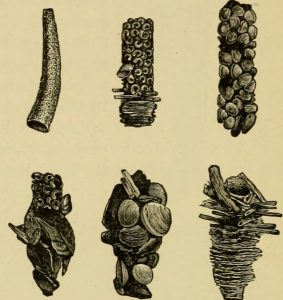
Image from page 105 of “Elementary entomology” (1912) showing the diversity of cases.
The first time that I heard about this unusual technique was during an internship in Wageningen (the Netherlands), where I had the opportunity to meet Dorine Dekkers. She has been working as an aquatic entomologist for many years. In addition, she has a very creative personality that triggers her imagination to carve fantastic stone sculptures in her free time. In 2012, she realised about the potential of combining both her passions (aquatic ecology and art) and decided to start creating jewelry by spreading a wide range of different gemstones in the aquaria as a substrate: lapis lazuli, malachite, turquoise, pyrite, black tourmaline, pink tourmaline, red jasper, sugilite, apatite, and white reef sand. As it is explained on her website [4], the larvae have a very gradual growth. Nevertheless, they keep incorporating gemstones to the silk case until they reach their final larval stage, a process that may take up to a month. As the case protects the caddisflies’ soft bodies during the growing period, they never leave it; instead, they use their front legs to move around while remaining attached to the case by a pair of powerful hooks at the end of their body [4]. When they reach the final larval stage, they pupate and become flying adults, leaving the cases empty and intact. It is then when they are ready to be collected and taken to the workshop without causing any harm to the insects. In the workshop, epoxy glue is used to cover the cases so they become more rigid. Then, they are left to dry for 24 hours. Afterwards, the cases can be combined with different elements such as rings or pins to create a variety of beautiful pieces [4].
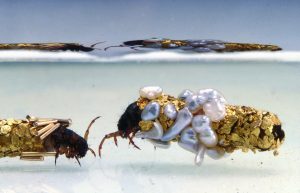
Two caddisflies carrying their cases made of gold flakes and pearls. Copyright Huber Duprat, imaged used under CC license.
Nevertheless, it is noteworthy that Dorine has not been the pioneer on this kind of art pieces. The original idea comes from France. Back in the 1980s, Hubert Duprat observed the fascinating building abilities of caddisflies and discovered that they could incorporate gemstones into their cases [5]. Unlike Dorine’s method, he removes the natural case (which might be made of gravel, twigs, etc.) before placing the unprotected larvae in a water tank, which has been previously filled with expensive and glamorous materials: gold nuggets, pearls, rubies, diamonds and turquoises. He patented the method and his creations were exhibited in galleries in France, Italy, Switzerland, and Russia [6]. Years later, in 1995, scientist Kathy Stout established a company in the US called Wildscape Inc. also specialised in jewelry created by caddisflies [7]. Whether the three of them came up with the same idea in different countries or knew about each other’s work is something not clear yet.
Caddisflies build cases and produce silk with high potential for many biomedical applications and they also play a very important role in freshwater ecosystems. For instance, they are a source of food for fish and other predators [8], they can serve as good indicators of the ecosystem health (e.g., some species are sensitive to temperature increase caused by deforestation [9]). In addition, they may act as ‘engineers’ in the ecosystem by stabilizing gravel bed sediments and capturing and transforming nutrients to be further used by other animals [8].

Some examples of Kathy’s pieces from the Wildscape Inc. website. From left to right: earrings, bracelet, and necklace.
For all these reasons, it is clear how important it is that we work together to protect them and ensure that their habitats are kept in a good ecological status. After all, they have been living in this planet for at least 200 Million years! [10].
* * *
By Luis Moliner Cachazo (@LMolinerCachazo), PhD student at King’s College London.
More information:
- Glue, fly, glue: Caddisflies’ underwater silk adhesive might suture wounds
- Lane et al., 2015
- Description of Caddisfly in Wikipedia
- Post written by Dorine Dekkers: “The jewelry of Caddisfly”
- Post at Colossal: “Artist Hubert Duprat Collaborates with Caddisfly Larvae as They Build Aquatic Cocoons from Gold and Pearls”
- The Caddisfly’s Mirror
- Wildscape Inc.
- Morse et al., 2019
- Kalaninová et al., 2014
- Mouro et al., 2016

